Cecil John Charles Street, MC, OBE, who was known to his colleagues, family and friends as John Street, began his military career as an artillery officer in the British Army. During the course of World War I, he became a propagandist for MI7, in which role he held the rank of Major. After the armistice, he alternated between Dublin and London during the Irish War of Independence as Information Officer for Dublin Castle, working closely with Lionel Curtis. He later earned his living as a prolific writer of detective novels.
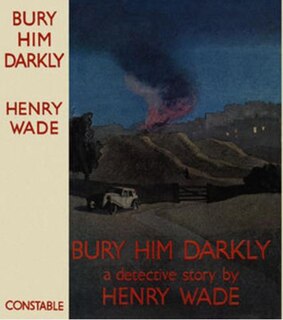
Bury Him Darkly is a 1936 mystery detective novel by the British writer Henry Wade. It was the fourth in a series of seven novels featuring the character of Inspector Poole. Along with the following Poole novel, Lonely Magdalen, it marked a shift towards more realistic police procedurals that has been described as pioneering. Superintendent Fraser, who appeared in Wade's fist novel The Verdict of You All, also appears as one of the characters.
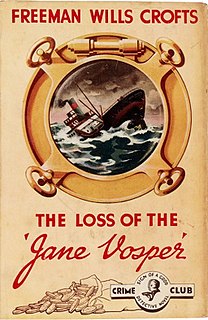
The Loss of the Jane Vosper is a 1936 detective novel by Freeman Wills Crofts. It is the fourteenth in his series of novels featuring Inspector French, a Scotland Yard detective of the Golden Age known for his thorough technique. It particularly dwells on the process of police procedure.

Hendon's First Case is a 1935 detective novel by John Rhode, the pen name of the British writer Cecil Street. It is the twenty first in his long-running series of novels featuring Lancelot Priestley, a Golden Age armchair detective. The novel introduced the character Inspector Jimmie Waghorn, a graduate of the newly established Hendon Police College. Over time Waghorn would increasingly become the dominant figure of the series, taking over the role from Priestley who took up a smaller, advisory role.
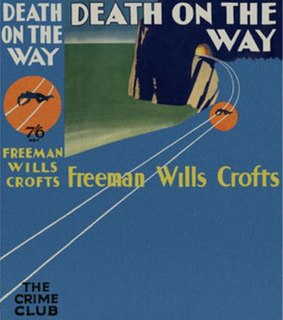
Death on the Way is a 1932 detective novel by the Irish writer Freeman Wills Crofts. It is the ninth in his series of novels featuring Inspector French, a prominent figure of the Golden Age of Detective Fiction. It was published in the United States the same year by Harper under the alternative title Double Death.
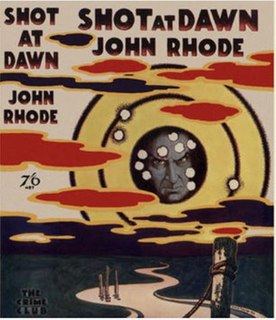
Shot at Dawn is a 1934 detective novel by John Rhode, the pen name of the British writer Cecil Street. It is the nineteenth in his long-running series of novels featuring Lancelot Priestley, a Golden Age armchair detective. It was one of the best received novels in the series. In a review in the Sunday Times Dorothy L. Sayers wrote "Mr. John Rhode is one of those kind, thoughtful writers who patiently explain all the technical points of the narrative in words that a child could understand." Ralph Partridge in the New Statesman observed "Shot At Dawn is developed in that incalculable way which keeps one’s attention at the stretch, until the very last page—I actually got a thrill out of the verdict of the jury! The Crime Club has selected the book, and I certainly could not better their selection from the detective novels that have come my way in the last few months."

Family Affairs is a 1950 detective novel by John Rhode, the pen name of the British writer Cecil Street. It is the fifty first in his long-running series of novels featuring Lancelot Priestley, a Golden Age armchair detective. It was published in America by Dodd Mead under the alternative title The Last Suspect. It has been described as "probably the best post-war Rhode novel".

The Secret of High Eldersham is a 1930 detective novel by Miles Burton, the pen name of the British writer Cecil Street. It was the first novel in a lengthy series featuring the detective Desmond Merrion. Street was one of the most prolific authors of the Golden Age of Detective Fiction and had already enjoyed success with his Doctor Priestley series, written under the name of John Rhode. In 1931 it was published in the United States by the Mystery League under the altered title The Mystery of High Eldersham. Originally published in Britain by the Collins Crime Club, it was reissued in 2016 by British Library Publishing as part of a series of crime novels the Golden Age.

This Undesirable Residence is a 1942 detective novel by the British writer Cecil Street, writing under the pen name of Miles Burton. It was part of a lengthy series of books featuring the detective Desmond Merrion and Inspector Arnold of Scotland Yard. It was published in the United States by Dodd Mead under the alternative title Death at Ash House.

Beware Your Neighbour is a 1951 detective novel by the British writer Cecil Street, writing under the pen name of Miles Burton. It was part of a lengthy series of books featuring the detective Desmond Merrion and Inspector Arnold of Scotland Yard. Unlike much of the series it takes place in suburban rather than rural England. Reviewing the novel in The Spectator Esther Howard wrote " I always find that Mr. Burton has nearly the most colourless detectives, prose-style and plots of anyone in the business, and Beware Your Neighbour, death in an exclusive thoroughfare, though mechanically adequate, is entirely devoid of excitement."
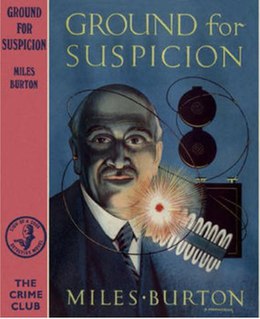
Ground for Suspicion is a 1950 detective novel by the British writer Cecil Street, writing under the pen name of Miles Burton. It was part of a lengthy series of books featuring the detective Desmond Merrion and Inspector Arnold of Scotland Yard. Maurice Richardson writing in The Observer considered it " Readable enough in its old-fashioned, consequential style.".

A Village Afraid is a 1950 detective novel by the British writer Cecil Street, writing under the pen name of Miles Burton. It was part of a lengthy series of books featuring the detective Desmond Merrion and Inspector Arnold of Scotland Yard.

Situation Vacant is a 1946 detective novel by the British writer Cecil Street, writing under the pen name of Miles Burton. It was the thirty fourth entry in a lengthy series of books featuring the detective Desmond Merrion and Inspector Arnold of Scotland Yard. As with much of the series it takes place in rural England.

Death Takes a Flat is a 1940 detective novel by the British writer Cecil Street, writing under the pen name of Miles Burton. It was the twenty-third in a series of books featuring the detective Desmond Merrion and Inspector Arnold of Scotland Yard. It was published in the United States by Doubleday under the alternative title Vacancy with Corpse.

Mr. Westerby Missing is a 1940 detective novel by the British writer Cecil Street, writing under the pen name of Miles Burton. It was the twenty-second in a series of books featuring the detective Desmond Merrion and Inspector Arnold of Scotland Yard. It was published in the United States by Doubleday the same year.
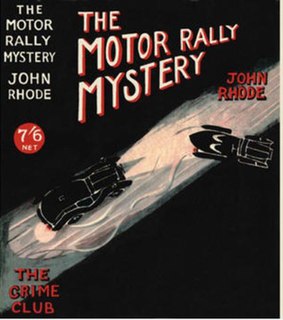
The Motor Rally Mystery is a 1933 detective novel by John Rhode, the pen name of the British writer Cecil Street. It is the fourteenth in his long-running series of novels featuring Lancelot Priestley, a Golden Age armchair detective. It was published in the United States by Dodd Mead under the alternative title Dr. Priestley Lays a Trap. It takes place against the backdrop of the real life RAC Motor Rally, which concluded at Torquay.
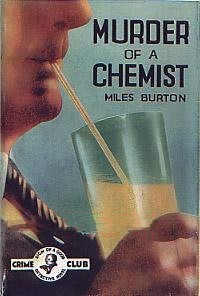
Murder of a Chemist is a 1936 detective novel by the British writer Cecil Street, writing under the pen name of Miles Burton. It is the fourteenth in a series of books featuring the Golden Age amateur detective Desmond Merrion and Inspector Arnold of Scotland Yard.
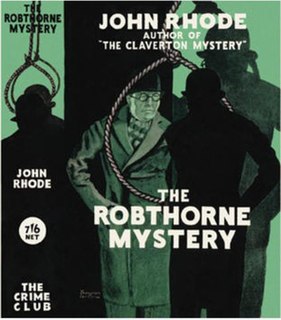
The Robthorne Mystery is a 1934 detective novel by by John Rhode, the pen name of the British writer Cecil Street. It is the seventeenth in his long-running series of novels featuring Lancelot Priestley, a Golden Age armchair detective. It was published in the United States the same year by Dodd Mead.
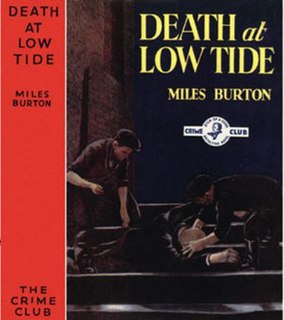
Death at Low Tide is a 1938 detective novel by the British writer Cecil Street, writing under the pen name of Miles Burton. It is the seventeenth in a series of books featuring the Golden Age amateur detective Desmond Merrion and Inspector Arnold of Scotland Yard. A review in the Times Literary Supplement declared "this is probably the best work of an author who has already had many brilliant successes". However The Observer noted "Miles Burton still remains faithful to the Crofts school in his austere refusal to develop a style."
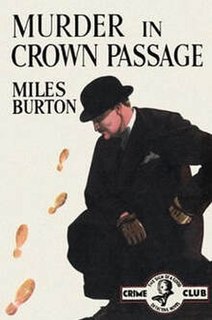
Murder in Crown Passage is a 1937 detective novel by the British writer Cecil Street, writing under the pen name of Miles Burton. It is the sixteenth in a series of books featuring the amateur detective Desmond Merrion and Inspector Arnold of Scotland Yard. Street was one of the most prolific authors of the Golden Age of Detective Fiction. It was published in the United States by Doubleday the same year under the alternative title The Man with the Tattooed Face. As often in the series, the setting is in rural England.



















